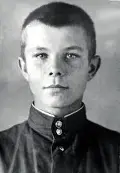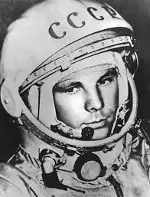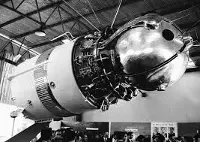Yuri Gagarin was the first person in space. His orbit of Earth on April 12, 1961, was a triumph for the Soviet Union in the Space Race with the United States and a triumph for all people.
He was born in Klushino, Russia, on March 9, 1934. He was 7 when German forces took over his village. A German officer  stationed himself in the Gagarin family house and forced the family to live in a mud hut that they built themselves. His older brother and older sister were forced into labor in Poland in 1943. After the war, the family moved to Gzhatsk. Young Yuri went to school there.
stationed himself in the Gagarin family house and forced the family to live in a mud hut that they built themselves. His older brother and older sister were forced into labor in Poland in 1943. After the war, the family moved to Gzhatsk. Young Yuri went to school there.
He found work in a Moscow metalworks when he was 16 and then started studying at a technical school in Saratov. He joined a flying club and found his calling, making his first solo flight in 1955. He graduated from the Orenburg Aviation School in 1957 and became a fighter pilot.


Gagarin was one of 20 selected for the Soviet space program in 1960. (The number who had applied initially topped 3,000.) He was eventually named the first in space. And so he was, blasting off at 9:07 a.m. on Aril 12, 1961, aboard the Vostok 1 spacecraft, from the Baikonur Cosmodrome. He is reported to have uttered one word shortly after blastoff: "Poyekhali!" Various translations into English have that as "Let's go!" or "Off we go!"
His spacecraft had few onboard controls because no one knew how the human body would respond to being in space. Flying the craft were the engineers on the ground. Onboard were 10 days' worth of supplies, in case of engine failure.

He was the first human in space, reaching a maximum height of 203 miles above the surface of the planet and completing one orbit of Earth in 108 minutes. He had no problems in the air but nearly met with disaster when landing. The cables connecting the two modules of his spacecraft did not separate as they were supposed to, and the spacecraft shook violently as it re-entered Earth's atmosphere. Gagarin had to eject; thanks to his parachute, he landed safely near the village of Uzmoriye, near the Volga River. He had to depend on a local farmer to telephone his whereabouts to space program authorities.
He was immediately an international celebrity. He was the focal point of parades around the world. He was especially celebrated in his own country. Streets and monuments bore his name. He was awarded the Order of Lenin and proclaimed a Hero of the Soviet Union, the country's highest honor.
Gagarin returned to the space program in the late 1960s, training other cosmonauts, and was a backup selection for the Soyuz 1 mission, a planned in-space rendezvous with Soyuz 2. Gagarin's friend and comrade Vladimir Komarov died when Soyuz 1 crashed to the ground.

Gagarin died in action near Kirsach on March 27, 1968. He was flying with Vladimir Seryogin in a two-seater MiG fighter jet on a routine training flight when the plane crashed, killing occupants. The cause of the crash was, many years later, revealed to be another plane's flying too close to Gagarin's plane.
He had married Valentina Gagarina in 1957, on the same day that he graduated from flight school. They had two children, Yelena and Galina.
Gagarin's historic spaceflight took place against the backdrop of the Cold War Space Race between the United States and the Soviet Union. Americans mourned his loss right along with Soviets; and when the Apollo 11 astronauts landed on the Moon in July 1969, they left behind a medallion that had Gagarin's name on it.